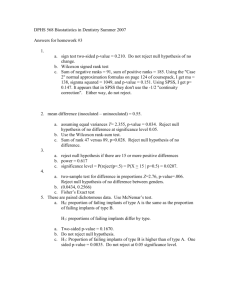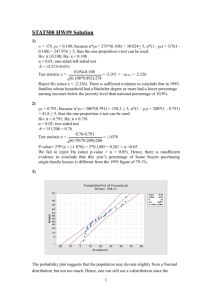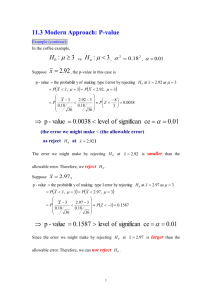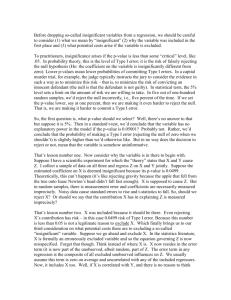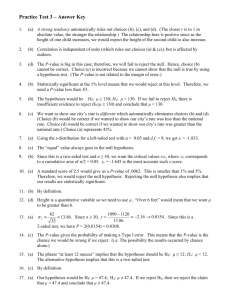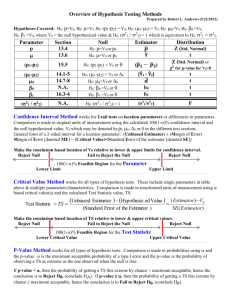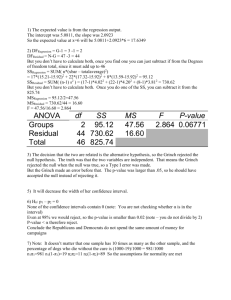Document
advertisement
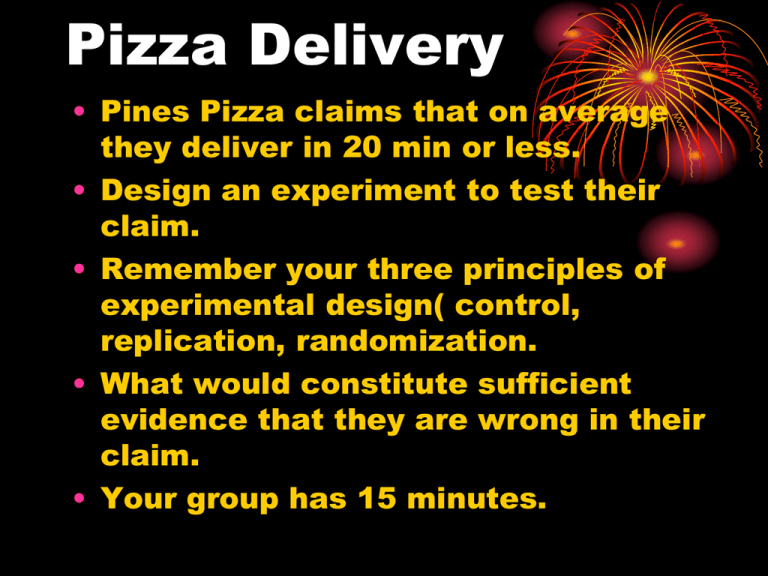
Pizza Delivery • Pines Pizza claims that on average they deliver in 20 min or less. • Design an experiment to test their claim. • Remember your three principles of experimental design( control, replication, randomization. • What would constitute sufficient evidence that they are wrong in their claim. • Your group has 15 minutes. Mr. Pines says that his twelve round washer score average is at least 40 pts. Coach Enright says, “no way”. Coach Enright decides he will run some tests on this situation. • Ho : μ = 40 vs. Ha : μ < 40, where μ is the mean average of Mr. Pines twelve inning washer score. Rejecting the Ho • Determine what should be done with the following P-Values 1.P(Z < -1.43) = 0.0764, reject at the 10% level 1.P(Z > .34) = 0.3669, do not reject Ho 1.P(Z ≠ 2.87) = 0.0041, reject at the 1% level Is it Significant? (a) Mean = 536.7 P-Value = .0505 Do not reject Ho (b) Mean = 536.8 P-Value = .0496 Reject at 5% level (c) The sample mean only changed by a tenth, slight variation completely reversed our conclusion Sample size and p-value (a) n = 100 P-Value = .3628 not even close to rejecting null (b) n = 1000 P-Value = .1336 not enough to reject null (c) n = 10,000 P-Value = .0002 reject at any level Is the die fair? • Roll the die you were given 50 times, keep track of all rolls. • A fair die has a mean μ = 3.5 and standard deviation σ = 1.71. • Is there significant evidence at the 5% level based on your rolls that the true average of the die is not 3.5? • Show all work Back to the Real Die Recall that a real die has μ = 3.5 and σ = 1.71….last week we rolled the die 50 times. What sample mean would we need to get in order to reject the null(μ = 3.5 ) at the 5% level? What does P-Value mean? • P-value assumes Ho is true. • It is a percent. • It is the probability of your sample happening by chance if Ho is true. Type 1 and 2 errors • Type 1 error — Rejecting Ho when it’s true. • Type 2 error — Failing to reject Ho when it’s false. Type I and Type II errors Which type of error is more serious? …. You have to read the problem! Decreasing the chance of a type I error increases the chance of a type II error…and vice versa Type 1 and 2 errors • What is the probability of that error? • Type 1 is the alpha level. • Type 2 is β and complex and you do not have to know. • What is power? • Power = 1 - β It is the probability of correctly rejecting Ho when it is false. Type 1 and 2 errors • Ho: the space shuttle is safe—launch rockets. • Ha: the shuttle is not safe. Do not launch rockets. • What is a type 1 error and its consequence? • What is a type 2 error and its consequence? • Which is worse? • Draw this situation in a two-way table. A quality inspector plans to test a sample of 40 bottles of soft drink labeled as 20 ounces. If she finds the mean content to be less than 19.8 ounces, she will have the bottling machinery stopped and recalibrated. If it is known that the machine operates with a standard deviation of 0.75 ounces, what is the probability that the inspector will mistakenly stop a machine that is delivering a mean of at least 20 ounces per bottle? (A) .023 (B) .046 (C) .050 (D) .092 (E) .119 B Which of the following statements are true? I It is helpful to examine your data before deciding whether to use a one-sided or two-sided hypothesis test. II If the P-value is 0.05, the probability that the null hypothesis is correct is 0.05. III The larger the P-value, the more evidence there is against the null hypothesis. (A) I only (B) II only (C) III only (D) II and III (E) None of the above gives the complete set of true responses E Which of the following statements are true? I The P-value of a test is the probability of obtaining a result as extreme as the one obtained assuming the null hypothesis is true. II If the P-value for a test is .043, the probability that the null hypothesis is true is .043. III When the null hypothesis is rejected, it is because it is not true. (A) I only (B) II only (C) III only (D) I and III (E) None of the above gives the complete set of true responses A When leaving for school on an overcast morning, you make a judgment on the null hypothesis: The weather will remain dry. What would the results be of Type I and II errors? (A) Type I error: get drenched. Type II error: needlessly carry around an umbrella (B) Type I error: needlessly carry around an umbrella. Type II error: get drenched (C) Type I error: carry an umbrella, and it rains. Type II error: carry no umbrella, but weather remains dry. (D) Type I error: get drenched. Type II error: carry no umbrella, but weather remains dry. (E) Type I error: get drenched. Type II error: carry an umbrella, and it rains. B

